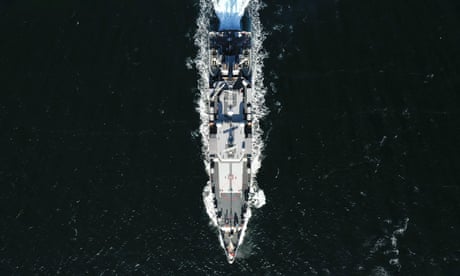- by foxnews
- 15 Mar 2025
Australia’s defence force faces once in a generation shake-up - but to what purpose?
Australia’s defence force faces once in a generation shake-up - but to what purpose?
- by theguardian
- 26 Feb 2023
- in news

As the Australian government considers the biggest defence shake-up in nearly four decades, it faces a blunt warning from a key strategist.
Australia's security outlook has worsened substantially, warns the former defence official Paul Dibb, who carried out the landmark 1985-86 defence review for the then Hawke government. He believes the structure of the Australian defence force needs a significant overhaul to match the times.
"We need to prepare ourselves for a very different and much more threatening strategic environment," says Dibb, an emeritus professor at the Australian National University who remains well connected with the defence establishment.
As the Albanese government prepares to invest more in long-range missiles and vast sums on nuclear-powered submarines, it has said the current Defence Strategic Review - which was handed to the government earlier this month - "should be seen in the same light as the Dibb review back in 1985-86 - it's as significant as that".
In an interview with Guardian Australia, Dibb calls for the Australian defence force to focus on maritime strike capabilities. He also suggests a "serious historical and cultural change" for the army in this new environment. And he warns of the risk of "high-intensity conflict from a country starting with C and ending with A but isn't Cambodia or Canada or Cuba".
China's military capabilities have expanded substantially since the then defence minister Kim Beazley commissioned the Dibb review 38 years ago.
Back then, Dibb's report described Australia as "one of the most secure countries in the world" as it was "distant from the main centres of global military confrontation, and it is surrounded by large expanses of water which make it difficult to attack".
In the 1986 report, he proposed a strategy of "denial" that would "allow our geography to impose long lines of communication on an adversary and force an aggressor to consider the ultimate prospect of fighting on unfamiliar and generally inhospitable terrain".
Key to this was ensuring an enemy would have substantial difficulty in crossing the sea and air gap. He called for ground forces to focus on light mobile operations in the north rather than forces involving armoured and mechanised operations and heavier artillery.
At that time, Dibb noted Australia's neighbours possessed only limited capabilities to project military power against it. He assessed that a global war between superpowers - meaning the then Soviet Union and the US - was "most unlikely and provides no basis for planning our force structure" - but warned that "it would not be prudent to assume that we will always be able to conduct our affairs without challenge".
The 1985-86 review accepted the prevailing strategic view that it would take at least 10 years for the development of a regional capacity to threaten Australia with substantial assault.
That was officially junked nearly three years ago, when the Coalition's defence strategic update concluded the risk of conflict was growing and Australia could no longer depend on a warning time of at least 10 years.
Dibb says that since the arrival of Xi Jinping as president, China has more assertively pressed its claims to the vast majority of the South China Sea, despite competing claims from other countries including Vietnam and the Philippines, and has built up military outposts on artificially constructed islands.
Dibb also cites "the stepping up last year of Chinese military aggression against Taiwan", some dangerous close encounters between the People's Liberation Army and the ADF, and the economic pressure Beijing sought to apply against Australia through trade measures. He says defence planners must take seriously the possibility of Chinese bases with military potential being established to Australia's north and north-east.
Dibb now advocates a policy of "deterrence by denial", whereby Australia develops the capability to attack an adversary's forces and any of the associated infrastructure directly threatening Australia. This would depend on the possession of highly credible accurate, long-range missile strike capabilities.
Together with Richard Brabin-Smith, an honorary professor in strategic and defence studies at the ANU, Dibb wrote in a paper that this concept was distinct from the much more demanding and expensive concept of "deterrence through punishment", which involves attacking the adversary's territory. They wrote: "In any case, the idea of Australia being able to inflict unacceptable punishment on a big power such as China would be ridiculous. The bottom line for defence policy is that, as confidence in deterrence by denial goes up, our dependence on early response to warnings should go down."
So what does this mean for the review carried out by the former defence chief Angus Houston and former Labor defence minister Stephen Smith?
"We need to refocus the ADF - and this is a non-trivial issue - so it is essentially a maritime strike capability," Dibb says.
"By maritime I don't just mean at sea or under the sea. I mean over the sea, with long-range strike missiles and long-range strike air force capabilities. The implications of that are that we need lots of long-range strike weapons - and we need to get a wriggle on. We have very few weapons in stockpile."
The aim, Dibb says, is to deny any potential adversary into not just Australia's close coastal areas, but into its strategic approaches out to a couple of thousand kilometres.
"The real test for this review will be to say to army: you're no longer going to be structured for fighting wars like Korea, Vietnam, Afghanistan and the Middle East, you actually have got to stop thinking about spending $27bn on infantry fighting vehicles," he says.
Scrapping the project to acquire up to 450 infantry fighting vehicles would trigger controversy within the army, which has argued it needs a replacement for Australia's Vietnam war-era armoured personnel carriers. Army figures have also warned against being too confident about predicting future wars.
But Dibb continues: "The new role for army in my view demands a serious historical and cultural change in the army leadership and that is, they should be equipped with trucks that have highly precise long-range strike missiles on them. You deploy them when necessary, to the north of Australia, on the big C-17s.
"The risk for army is when you launch a long-range precise strike missile at the incoming adversary's warships, for instance, you are then very vulnerable yourself to highly precise enemy weapon systems. You pack up the truck, put them in the C-17 and helter-skelter somewhere else."
Dibb says this is the kind of role that the US marines in the Pacific now see themselves having, including on the Japanese islands.
"The other role for army - equally novel and demanding - will be: why not give them the role for integrated air defence including missile air defence of our airfields, our ports, and our central military capabilities which should be hardened? That would be a dramatic change in role for the army."
None of this will be easy. Dibb played a major part in the writing of the subsequent 1987 defence white paper and then served as deputy secretary of the Department of Defence from 1988 to 1991, but recounts facing some institutional resistance when it came to actually implementing the plans.
Dibb says acting on the looming Houston-Smith review is going to be a test for the Albanese government - but it will also be a test for the opposition. "It should be bipartisan. And if I'm right about what the priorities are, including for army, I would be bitterly disappointed if Peter Dutton played some political games."
The defence minister, Richard Marles, has signalled that he is prepared to wind back existing programs in order to fund higher priorities, even against a backdrop of rising defence spending overall (it currently sits around 2% of gross domestic product). In a hint of where he is going, Marles says Australia needs to think about "how we hold any potential adversary at risk at greater distance from our shores". He has used the phrase "impactful projection".
Tom Corben, a research fellow in the foreign policy and defence program at the United States Studies Centre at the University of Sydney, thinks this "really refers to Australia's ability to project military force from the homeland or from Australia's immediate region further into Asia, through means like long-range strike, through things like submarines, through things like autonomous systems and long-range aircraft".
"I think it means value as well - not simply projecting force to 'show the flag' and show that we have interests in stake in the region, but to be credible in those projections of force and our ability not only to act on them in the first instance if we need to, but to sustain that action if it came to it," Corben says.
He expects to see a relative shift in emphasis from simply defending the Australian continent - which will still remain a planning priority - towards the wider region. That reflects "a perception that the key challenges to Australia's regional interests lie out in the region itself".
Corben says the strategy seeks to "make it as costly as possible for China to seize control of contested or disputed land features or oceans by force, whether that be around Taiwan or in the South China Sea or elsewhere".
"I think what we want to ensure in the region is that the rules for how interstate relations are conducted, how territorial disagreements and control are resolved, how trade is conducted - we want all of those things to be worked out in an environment where power doesn't disproportionately affect the outcome of those negotiations, or the threat of the use of military, political or economic coercion against a smaller state - to ensure the bigger powers don't win out simply because they're bigger," Corben says.
"That's more or less the kind of situation that Australia wants to avoid, because it is under more open conditions that Australian interests in the region have thrived in the last couple of decades."
- by foxnews
- descember 09, 2016
Neighbors react as viral 'Tunnel Girl' granted permit to continue digging massive bunker under home
"Tunnel Girl" in Herndon, Virginia, "finally" got her tunnel project approved after pausing the project due to a potential violation. Locals and social media users react.
read more


